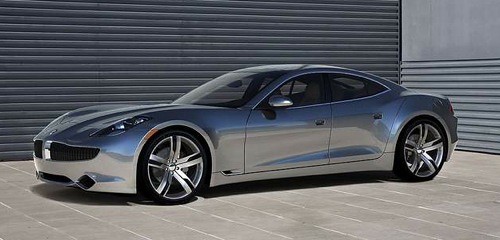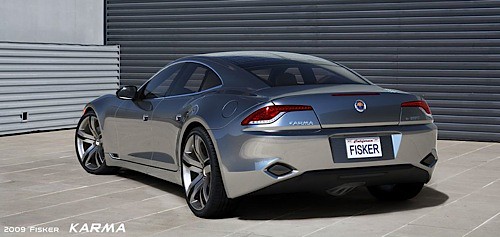

Wow, this is a great looking car. The grill has been widened to aid in air intake and cooling for the 2.0L EcoTec four cylinder from GM. Kind of a huge powerplant for just extending the electric range and not driving the wheels. The electric motor will be at the back, and you can see in the shot the back end of the car now has an air diffuser that sucks the hot air out of the electric motor. I think this makes it look very cool. Compare it to the previous back end:

[Source: Fisker]
Fisker Automotive’s First Production Vehicle, the Fisker Karma, to Be Showcased at the North American International Auto Show (NAIAS)
IRVINE, Calif., Dec. 2 — Fisker Automotive, Inc., a green American premium sports car company, today announced that its first production car, the Fisker Karma, will be showcased at the North American International Auto Show (NAIAS). With only minor design enhancements made to the exterior of the vehicle, the production Fisker Karma plug-in hybrid retains the extreme proportions and beautiful sculpture of the January 2008 Karma show car.
“We are very excited to be bringing the Fisker Karma back to NAIAS,” said Fisker Automotive CEO Henrik Fisker. “In the year since we debuted the Karma, the reception we’ve received has been tremendous. I’m proud to announce at this time that we are already sold out on the car until mid-2010.”
With a base price of $87,900 (USD), the Fisker Karma is scheduled to begin delivery in November 2009. Featuring the proprietary Q-Drive powertrain, the Fisker Karma will have an all-electric range of 50 miles (80km). After the all electric 50 miles, the gasoline engine turns a generator to charge the lithium ion battery. Once the 50-mile electric range has been exceeded, the Fisker Karma can be used as a normal hybrid vehicle. With this balance of electric and gas range, Fisker Automotive estimates that most Karma drivers who charge the Karma overnight and commute less than 50 miles per day will be able to achieve an average fuel economy of 100 mpg (2.4L/100km) per year.
The production model to be featured at the 2009 NAIAS will include an upper grill that is graphically enhanced, being slightly larger towards the outer corners. The lower air intake has been enlarged to allow for more airflow and underneath the rear bumper, an aerodynamic diffuser includes the integration of a cooling cover for the electric drivetrain.
To optimize cooling and aerodynamics, the exhaust pipe from the ICE engine is routed directly out behind the front wheels. A small functional side vent will release the hot air when the ICE engine is turned on. The Fisker Karma also features a complete flush B-pillar. The B-pillar is a safety feature and already fulfills the proposed 2012 rollover protection safety regulations.
Underneath the Karma is an all aluminum spaceframe made in cooperation with Norsk Hydro. The exterior body is a combination of aluminum panels and composite panels.
The Karma has a unique sustainable interior strategy. The design of the interior cabin is a luxurious tailored space for four adults. The interior will be unveiled for the first time in its final form at the 2009 NAIAS.
The vehicle’s ride and handling is decisively sporty and includes very responsive steering. The Karma’s long wheel base, wide track and low center of gravity provide excellent cornering and stability at highway speeds.
The innovative powertrain, Q-drive, utilizes a large, powerful lithium ion battery and a powerful 2-liter direct injected turbo-charged 4-cylinder gasoline engine developing 260 hp, which enables the Karma to achieve a continuous top speed of 125 mph and a 0-60 of 5.8 seconds. The large powerful lithium ion battery provides 22.6 kWh, which has unique control software. The two powerful electric motors deliver a combined 408 hp.
Additional features of the Karma include:
Karma Powertrain “Q-Drive”
Powertrain Overview Description
The Karma powertrain is a high performance, high efficiency, plug-in hybrid electric system comprised of three electric machines, three inverters, a turbo-charged 2.0 L high-feature DI gasoline engine and an advanced Lithium- ion technology battery pack. This hardware combination coupled with the innovative Q-Drive control system provides for a unique driving experience where energy, power, feel, and fuel economy are optimized to satisfy driver demands.
Energy Storage System
The energy storage system incorporates an advanced lithium-ion chemistry battery pack with integrated control and safety systems that ensure safe and powerful operation throughout the operating life. The system has a maximum storage capacity of 22.6 kW-hrs and is capable of delivering a peak electric power of 200 kW (500 Amps at 400 Volts) throughout the charge depleting range of operation. The Advanced Lithium Power battery pack has been designed for the rigorous requirements of the automotive environment, and is a full “plug and play unit” utilizing all advanced vehicle communications software. The battery pack uses inherently safe cell chemistry and has been designed with multiple levels of software and hardware features to ensure optimal performance while providing the highest levels of safety features.
Powertrain Electric Traction
The power dense dual motor traction drive is capable of delivering a peak output mechanical power of 300 kW (408 hp) and a peak torque of 1300 Nm (959 Ft-lb) to the input of the differential. In Sport mode this provides for a high performance luxury sport sedan acceleration time of 0 to 60 mph (0-100 km/h) in less than 6 seconds. The sustained (electronic limited) top speed is 125 mph (200 km/h).
